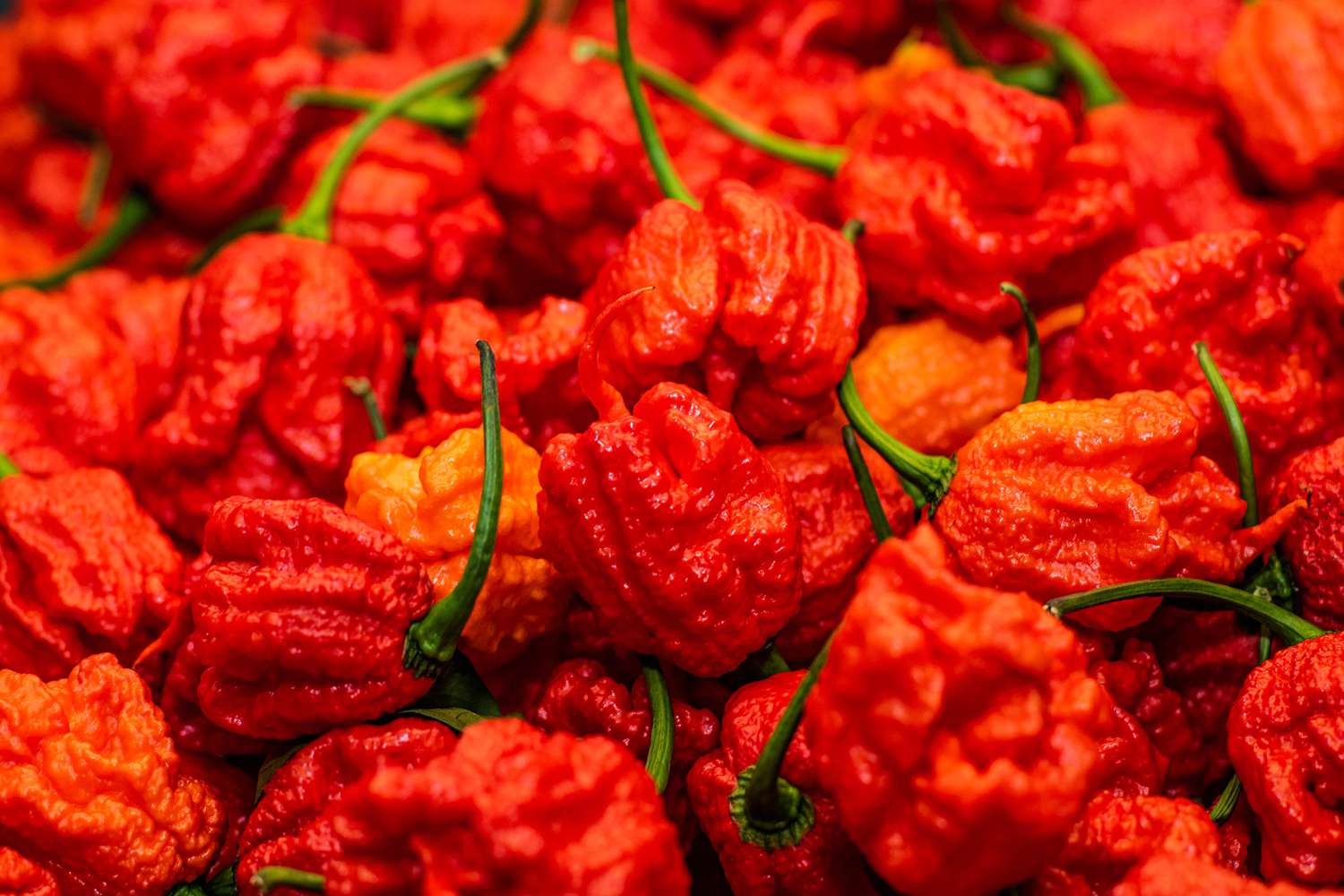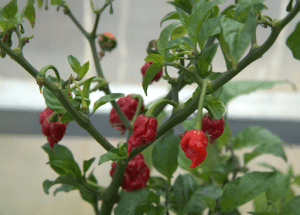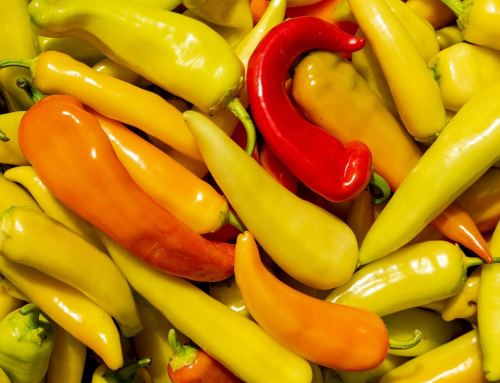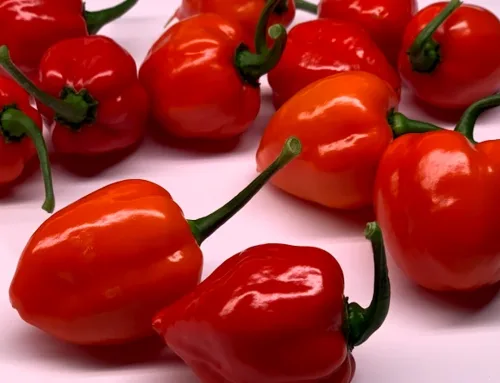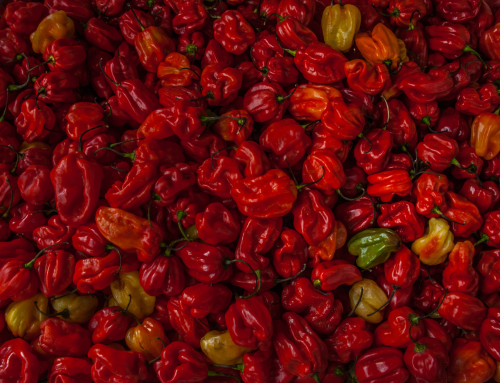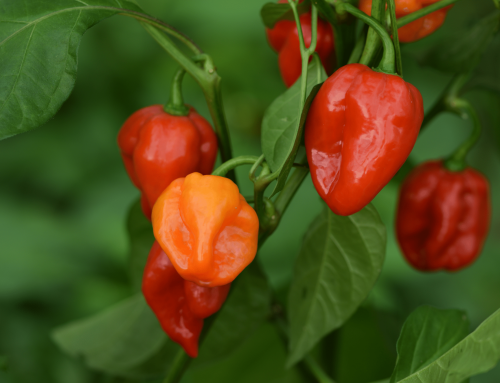Among chili peppers that offer diverse flavors and heat levels, one pepper stands out for its scorching reputation—the Carolina Reaper. Not for the faint of heart, the Carolina Reaper can deliver a scorching heat of up to 2.2 million Scoville Heat Units (SHUs), which is about 400 times hotter than a jalapeño. But behind the heat, there is also a sweet-ish, fruity flavor that makes this pepper extremely versatile to cook with.
At Magic Plant Farms, we specialize in growing, processing, and selling chili peppers and spices from different regions of the world. Although we offer a wide range of peppers and their products – flakes, powder, puree, mash, hot sauce, and more – Carolina Reaper is one of our favorites. This small, red, gnarled pepper with a scorpion-like tail can add complexity and depth to any dish you can think of.
So, in this post, we are going to explore everything you need to know about the Carolina Reaper and how to use it to take you on a culinary adventure that pushes the boundaries of spiciness. From where it came from, to how to create the spiciest hot sauce with it, we are going to dive into it all.
Carolina Reaper Peppers: The Hottest Chili Pepper
This pepper was created through a quest to develop the hottest pepper in the world. This hottest super-hot chili pepper was formed by crossing a Pakistani Naga Viper pepper with a Red Habanero type from St. Vincent Island in the West Indies. Due to its striking resemblance to the Grim Reaper’s scythe, it was named the Carolina Reaper.
In 2012, this pepper was submitted to the Guinness World Records for evaluation. After undergoing rigorous testing, it was officially declared the world’s hottest pepper in 2013, surpassing the previous record holder, the Trinidad Scorpion “Butch T” pepper. According to tests conducted by Winthrop University in South Carolina, the official Guinness World Record heat level reached 1,641,183 SHUs in 2017. It’s important to note that this figure represents the average for the tested batch, with the hottest individual Reaper measuring at 2.2 million SHUs.
👉Also read: Spice Up Your Culinary Game With The Best Carolina Reaper Recipes
What’s the big deal about Scoville Heat Units (SHUs)?
No conversation about hottest chili peppers is complete without the mention of Scoville Heat Units – but do you know what it really means?
SHUs are a measurement of the heat level or spiciness of chili peppers. They are named after their creator, an American pharmacist who developed the scale in 1912.
The Scoville scale technically measures the concentration of capsaicinoids, the chemical compounds that give chili peppers their spicy taste and heat. Capsaicin is the most predominant and potent capsaicinoid, and it is responsible for most of the sensory effects of chili peppers, such as burning, pain, sweating, and tears.
The Scoville Organoleptic Test was the original method used to measure Scoville units by diluting a chili pepper extract with sugar water until its heat was no longer detectable by a panel of trained tasters. The amount of dilution required to reach this point was then converted into Scoville units. For example, a jalapeño pepper that requires 5,000 times dilution to lose its heat would have a rating of 5,000 SHUs.
Based on this, since different people, i.e., tasters, have different sensitivities and tolerances to capsaicinoids, this technique was subjective as well as imprecise. So, a more accurate method was developed later, using a High-Performance Liquid Chromatography (HPLC), which measures the amount of capsaicinoids directly from the chili pepper sample. The higher the amount, the higher the SHUs.
Learning about the SHUs scale is important because it helps you compare and categorize different chili peppers based on their heat level. They tell you how much capsaicinoids you are consuming and how they affect your body. For example, capsaicinoids have been shown to have various pain relief, anti-inflammatory, anti-cancer, and weight loss benefits. Incorporating chili peppers with high SHUs in your palate could offer health benefits you didn’t even know about.
How Does Carolina Reaper Compare With Other Hot Peppers?
The Carolina Reaper is currently the hottest chili pepper in the world according to the Guinness Book of World Records – but it’s not the only one. There are many other peppers that come close or even surpass it in terms of heat level. Here are some other popular, extremely hot peppers that rank high on the Scoville scale:
Pepper X: This is the newest pepper that claims to be twice as hot as the Carolina Reaper. The unconfirmed reports has this pepper tested at 3.18 million SHUs.
Dragon’s Breath: Developed by a chili farmer in collaboration with NPK Technology and Nottingham Trent University, Dragon’s Breath pepper reportedly has a heat level of 2.48 million SHUs. Interestingly, it’s makers claim that it can serve as a natural anesthetic for people allergic to standard lab-made anesthetics.
Trinidad Moruga Scorpion: It’s a native to Trinidad and Tobago and was the previous record holder for the hottest chili pepper before the Carolina Reaper. It averages at around 1.2 million SHUs and has a sweet, fruity flavor with a searing heat that builds up over time.
Bhut Jolokia (Ghost Pepper): This is a pepper native to India and was the first pepper to break the 1 million SHUs mark. Described as having a distinctive sweet fruity flavor with an intense and lasting heat, Bhut Jolokia can go up to 1.04 million SHUs.
Compared to all these peppers, the Reaper really stands in terms of its flavor profile. It has a sweet, fruity-ish flavor, with hints of cinnamon and chocolate, but this flavor is quickly overshadowed by its extreme spiciness. Some people describe the sensation of eating a Reaper pepper as swallowing lava or fire. Of course, the flavor and the heat of each pepper can vary depending on the growing conditions, the ripeness, and the preparation of the pepper.
How to Grow High-Quality Carolina Reaper Peppers
If you are feeling adventurous and want to grow your own Carolina Reapers, you are going to need a lot of patience and attention-to-detail. These peppers need very specific conditions and a long growing season, which makes them not the easiest to grow. That said, cultivating them can be a really rewarding experience as you’ll get to enjoy the fruits of your labor and impress your friends and family with your culinary skills.
As your trusted Reaper growers, here are our best tips on growing these peppers from seeds:
Start with seeds
You can buy Carolina Reaper seeds online or from specialty stores. You can also save seeds from fresh or dried peppers, but make sure they are not hybrid or cross-pollinated. You will need to start your seeds indoors about 8 to 10 weeks before the last frost date in your area.
Prepare the seeds
To increase the germination rate and speed up the process, you can soak the pepper seeds in black tea for about 30 minutes before planting. This will help soften the seed coat and stimulate the growth.
Plant the seeds
Fill a small pot or a seed tray with a well-draining potting mix. Make a small hole about 1/4 inch (0.6 cm) deep and place one seed in each hole. Cover lightly with soil and water gently. Keep the soil moist but make sure it’s not soggy. Place this pot in a warm place, ideally between 80°F to 85°F.
Wait for germination
It can take anywhere from 7 to 40 days for the seeds to sprout, depending on the temperature and the quality of the seeds. Be patient and keep checking the soil moisture. Once the seedlings emerge, move them to a bright spot with at least 6 hours of direct sunlight per day.
Transplant the seedlings
When the seedlings have developed their first true leaves, transplant them into larger pots with drainage holes and a well-draining potting mix. Be careful not to damage the roots when transferring the seedlings. Water well after transplanting and keep them in a sunny spot indoors until they are ready to move outside.
Harden off the plants
Before moving the pepper plants outside, you need to acclimate them to the outdoor conditions gradually. This process is called hardening off and it helps prevent any shock and damage to the plants. Start by placing them outside for a few hours a day in a shaded spot, then gradually increase the time and exposure to sun over a week or two. Avoid exposing them to strong winds, rain, or frost.
Choose a location
Carolina Reaper peppers love heat, so pick a location that gets at least 6-8 hours of direct sunlight per day. These plants also prefer well-drained soil with a pH level of around 6.5. You can test your soil pH with a kit or a meter and modify it accordingly with lime or sulfur (if needed).
Plant your peppers
When the danger of frost has passed and the soil temperature is above 70°F, plant the peppers outside. Space them about 18 inches (45 cm) apart in rows that are 3 feet (91 cm) apart. Dig a hole slightly larger than the root ball of each plant and place them in the hole at the same depth as they were in their pots. Fill in the hole with soil and water well. You can also add some mulch around the plants to conserve moisture and prevent weeds.
Water and fertilize
Reaper plants need to be watered regularly, especially during hot, dry weather. So, water thoroughly once or twice a week, depending on the soil moisture and weather conditions. Avoid overwatering or underwatering, as both can cause stress and reduce yield.
You can also fertilize the peppers every two weeks with a balanced fertilizer that is low in nitrogen and high in phosphorus and potassium. This will help promote flowering and fruiting without resulting in excessive foliage growth. Avoid overfertilizing or using high-nitrogen fertilizers since they can cause blossom end rot or reduce heat level.
Stake, mulch, and prune
Get ready for your Carolina Reaper peppers to grow up to 4 feet (1.2 m) tall and 6 feet (1.8 m) wide, which means you’ll need to provide them some kind of support to prevent them from falling over or breaking. Most growers use trellises, cages, and stakes to keep them upright and secure.
To add a protective layer for the roots and help maintain a more stable growing environment, consider mulching around the plants with straw, wood chips, or plastic. We also recommend pruning the peppers to remove any diseases or dead branches. This will improve air circulation, which can increase the yield.
Harvest and handle
Once the peppers turn firm and a bright shade of red, they are ready to be harvested – this is usually about 90 to 120 days after transplanting. You can use scissors or a knife to cut them off the plant, but leave a short stem attached.
Wear gloves and eye protection gear during this process; close contact with the peppers can lead to severe irritation and pain. Avoid touching your face or other sensitive areas, and don’t forget to wash your hands thoroughly after harvesting. Store your fresh Carolina Reaper peppers in a cool and dry place, or preserve them by drying, freezing, canning, or making hot sauce.
👉Also read: How To Use Scorpion Pepper Products To Spice Up Your Dishes
Different Types of Carolina Reaper Chili Pepper Products Available
If you are looking to spice up your dishes, there is a world of Carolina Reaper products out there waiting to be explored. Some of the most popular ones include:
Whole Dried Carolina Reaper Pepper
These are whole pods of the Reaper peppers that have been dried and preserved, but still retain their original color and flavor. If you’re making a recipe that calls for fresh peppers, you can rehydrate the dried pods by soaking in warm water for 10-15 minutes. Or, grind them into powder or flakes and store for a long time. Whole dried peppers are ideal for making your own hot sauce, salsa, chili, soup, stew, barbecue, jerky, and more.
Carolina Reaper Seeds
The seeds of Carolina Reapers are small, oval-shaped, and yellowish in color. You can use them to grow your own hottest peppers.
Carolina Reaper Powder
This fine powder is made from ground dried Carolina Reaper peppers. It has a bright red color and a potent aroma and flavor; it’s very concentrated so a little bit goes a long way. It’s terrific for sprinkling on your favorite foods as a seasoning, or you can mix it with salt or sugar for a spicy rim on your drinks.
Carolina Reaper Sriracha Powder
If you want a bit more flavor to your Reaper powder, try Magic Plant Farms’ Carolina Reaper Sriracha powder. It’s made from dried, ground Reapers plus other ingredients like garlic, vinegar, sugar, and salt. As the name suggests, it’s a variation of the popular Sriracha sauce, but with a much higher heat level. It can be used as a rub, a dip, or a dressing for any dish you want – noodles, rice, eggs, pizza, burgers, tacos, wings, and more.
Carolina Reaper Flakes
These are small pieces of dried Reaper peppers that have been crushed or chopped. They have a similar color and flavor as the powder, but with a coarser texture. Reaper flakes are highly concentrated and should be used sparingly. For that extra fiery kick, add them to your sauces, marinades, rubs, seasonings, curries, stews, salsas, stir fries, and pizza toppings.
Carolina Reaper Mash
Carolina Reaper Mash is thick and chunky that contains the skin, seeds, and flesh of the peppers. Also, it’s made from freshly harvested Reapers that have been fermented with salt and citric acid. Naturally fermented mean the mash has much more flavor than, say, dried pods. It’s dry consistency makes it easy to add balanced heat throughout any spicy foods you add it to.
Carolina Reaper Infused Oil
If you want to try something different, consider creating a flavorful edible oil that captures the intense heat and distinct taste of Carolina Reaper peppers. All you need is a high-quality cooking oil (olive oil, coconut oil, sunflower oil, or sesame oil) and a couple of dried or fresh hot peppers. This infusion is the perfect way to add spiciness to your cooking – or you can drizzle it directly on your roasted veggies, pasta dishes, salads, and sautés as a finishing touch.
Carolina Reaper Peppers: Beyond the Heat
Earlier, we talked about capsaicinoids: they are chemical compounds that give hot peppers their burning spiciness. What you might not know is that capsaicinoids can stimulate the nerve endings in your mouth and other parts of the body, causing a sensation of heat and pain. No, it’s not a bad thing – this actually triggers the release of endorphins, the natural painkillers of the body, which can reduce or block the pain signals.
Over time, as you continue to consume the hottest pepper, the capsaicinoids can also desensitize the nerve endings and make them less responsive to pain stimuli. If you’re experiencing pain due to diabetic neuropathy, arthritis, shingles, or a surgical procedure, capsaicinoids can provide significant relief.
And if you’re looking to shed some pounds, Carolina Reaper may help with that as well. Research suggests that capsaicinoids can increase energy expenditure (calorie burning) by activating brown adipose tissue, which is involved in thermogenesis. This increased metabolic activity may help you burn more calories and thus, get rid of some of those unwanted pounds.
The capsaicinoids in Reaper peppers have also shown to reduce appetite by stimulating satiety signals in the brain. Simply put, eating super hot peppers will make you feel more satisfied and less hungry, so you may be able to reduce the amount of food you eat.
👉Also read: How To Cook With Different Ghost Pepper Products
Beyond Culinary: Other Uses of Carolina Reaper Peppers
You have whipped up enough mash, flakes, hot sauce, powder, and seasoning blends to spice up your life for a long time, and yet, you’re still drowning in a sea of Reaper peppers. What else can you do with these red-hot beasts? Don’t worry, we have some tips for you:
- Mix fresh or dried peppers into alcohol, such as vodka, without straining the flakes. Let the mixture infuse for a period of time. This process allows the fiery essence of the peppers, including the flakes, to permeate the alcohol, creating a potent and spicy pepper-infused vodka. Before use, strain the mixture to remove any remaining solid particles, while ensuring the flakes are retained for maximum flavor. The resulting vodka can then add a flavorful kick to your cocktails or be enjoyed on its own.
- You can use this Reaper pepper spray as a homemade pest deterrent too. Its intense spiciness works great in repelling insects, rodents, birds, and other small animals.
- You can create a natural anesthetic balm for temporary pain relief by mixing Reaper powder with aloe vera gel or coconut oil. But please consult with your doctor before applying it on the affected areas.
Magic Plant Farms: Your One-Stop Shop for Fresh Carolina Reaper Products
If you are ready to take your taste buds to the next level, check out Magic Plant Farms’ offerings made from high-quality Carolina Reapers. We grow our own spicy peppers in farms around the world and turn them into delicious products that are kosher, and gluten-free. You can order online or find them in stores near you.

